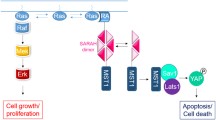Abstract
Time-resolved fluorescence resonance energy transfer, TR-FRET, is a time-gated fluorescence intensity measurement which defines the relative proximity of two biomolecules (e.g., proteins, peptides, or DNA) based on the extent of non-radiative energy transfer between two fluorophores with overlapping emission/excitation spectra. In these assays, an excited lanthanide ion acts as a “donor” that transfers energy to an “acceptor” fluorophore through dipole–dipole interactions. A FRET signal is reported as the ratio of acceptor to donor emission following donor excitation. When a donor-conjugated protein interacts with an acceptor-conjugated protein, the donor and acceptor fluorophores are brought in close proximity allowing energy transfer from the donor to the acceptor resulting in a FRET signal. Because the lanthanide donors have a long emission half-life, the energy transfer measurement can be time-gated, which dramatically reduces assay interference (due to background autofluorescence and direct acceptor excitation) and thereby increases data quality. Here, we describe a TR-FRET assay that monitors the interaction of the estrogen receptor (ER) α ligand binding domain (labeled with a terbium chelate via a streptavidin–biotin interaction) with a sequence of coactivator protein SRC3 (labeled directly with fluorescein) and the disruption of this interaction with a peptide and a small molecule inhibitor.
Access this chapter
Tax calculation will be finalised at checkout
Purchases are for personal use only
Similar content being viewed by others
References
Tamrazi A, Carlson KE, Rodriguez AL et al (2005) Coactivator proteins as determinants of estrogen receptor structure and function: spectroscopic evidence for a novel coactivator-stabilized receptor conformation. Mol Endocrinol 19:1516–1528
Bramlett KS, Wu YF, Burris TP (2001) Ligands specify coactivator nuclear receptor (NR) box affinity for estrogen receptor subtypes. Mol Endocrinol 15:909–922
Mueller SO (2004) Xenoestrogens: mechanisms of action and detection methods. Anal Bioanal Chem 378:582–587
Rodriguez AL, Tamrazi A, Collins ML et al (2004) Design, synthesis, and in vitro biological evaluation of small molecule inhibitors of estrogen receptor a coactivator binding. J Med Chem 47:600–611
Becerril J, Hamilton AD (2007) Helix mimetics as inhibitors of the interaction of the estrogen receptor with coactivator peptides. Angew Chem Int Ed 46:4471–4473
Ozers MS, Ervin KM, Steffen CL et al (2005) Analysis of ligand-dependent recruitment of coactivator peptides to estrogen receptor using fluorescence polarization. Mol Endocrinol 19:25–34
Gowda K, Marks BD, Zielinski TK et al (2006) Development of a coactivator displacement assay for the orphan receptor estrogen-related receptor-gamma using time-resolved fluorescence resonance energy transfer. Anal Biochem 357:105–115
Liu JW, Knappenberger KS, Kack H et al (2003) A homogeneous in vitro functional assay for estrogen receptors: coactivator recruitment. Mol Endocrinol 17:346–355
Zhou GC, Cummings R, Li Y et al (1998) Nuclear receptors have distinct affinities for coactivators: characterization by fluorescence resonance energy transfer. Mol Endocrinol 12:1594–1604
Gunther JR, Moore TW, Collins ML et al (2008) Amphipathic benzenes are designed inhibitors of the estrogen receptor α/steroid receptor coactivator interaction. ACS Chem Biol 3:282–286
Gunther JR, Du Y, Rhoden E et al (2009) A set of time-resolved fluorescence resonance energy transfer assays for the discovery of inhibitors of estrogen receptor-coactivator binding. J Biomol Screen 14:181–193
Mathis G (1995) Probing molecular-interactions with homogeneous techniques based on rare-earth cryptates and fluorescence energy-transfer. Clin Chem 41:1391–1397
Kim SH, Gunther JR, Katzenellenbogen JA (2010) Monitoring a coordinated exchange process in a four-component biological interaction system: development of a time-resolved terbium-based one-donor/three-acceptor multicolor FRET system. J Am Chem Soc 132:4685–4692
Jeyakunnar M, Carlson KE, Gunther JR et al (2011) Exploration of dimensions of estrogen potency parsing ligand binding and coactivator binding affinities. J Biol Chem 286:12971–12982
Gunther JR, Parent AA, Katzenellenbogen JA (2009) Alternative inhibition of androgen receptor signaling: peptidomimetic pyrimidines as direct androgen receptor/coactivator disruptors. ACS Chem Biol 4:435–440
Parent AA, Gunther JR, Katzenellenbogen JA (2008) Blocking estrogen signaling after the hormone: pyrimidine-core inhibitors of estrogen receptor-coactivator binding. J Med Chem 51:6512–6530
Shukla SJ, Nguyen DT, MacArthur R et al (2009) Identification of pregnane X receptor ligands using time-resolved fluorescence resonance energy transfer and quantitative high-throughput screening. Assay Drug Dev Technol 7:143–169
Wang Y, Yang DZ, Chang A et al (2012) Synthesis of a ligand-quencher conjugate for the ligand binding study of the aryl hydrocarbon receptor using a FRET assay. Med Chem Res 21:711–721
Schaufele F (2011) FRET analysis of androgen receptor structure and biochemistry in living cells. Methods Mol Biol 776:147–166
Vogel KW, Marks BD, Kupcho KR et al (2010) Improved nuclear receptor binding assays for HTS by conversion from FP to TR-FRET readout. Endocr Rev 31
Hilal T, Puetter V, Otto C et al (2010) A dual estrogen receptor TR-FRET assay for simultaneous measurement of steroid site binding and coactivator recruitment. J Biomol Screen 15:268–278
Tamrazi A, Carlson KE, Daniels JR et al (2002) Estrogen receptor dimerization: ligand binding regulates dimer affinity and dimer dissociation rate. Mol Endocrinol 16:2706–2719
Author information
Authors and Affiliations
Corresponding author
Editor information
Editors and Affiliations
Rights and permissions
Copyright information
© 2015 Springer Science+Business Media New York
About this protocol
Cite this protocol
Moore, T.W., Gunther, J.R., Katzenellenbogen, J.A. (2015). Estrogen Receptor Alpha/Co-activator Interaction Assay: TR-FRET. In: Meyerkord, C., Fu, H. (eds) Protein-Protein Interactions. Methods in Molecular Biology, vol 1278. Humana Press, New York, NY. https://doi.org/10.1007/978-1-4939-2425-7_36
Download citation
DOI: https://doi.org/10.1007/978-1-4939-2425-7_36
Publisher Name: Humana Press, New York, NY
Print ISBN: 978-1-4939-2424-0
Online ISBN: 978-1-4939-2425-7
eBook Packages: Springer Protocols




